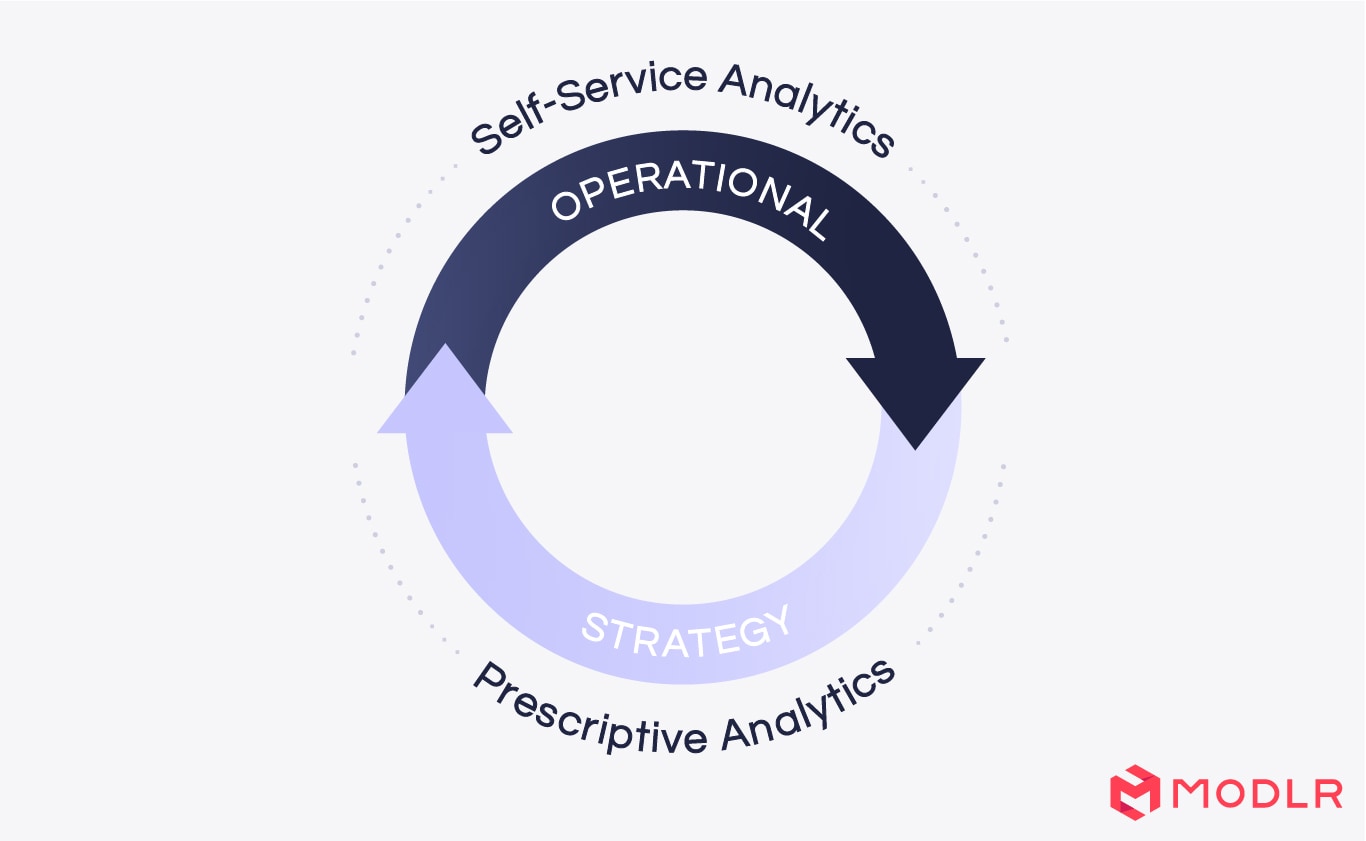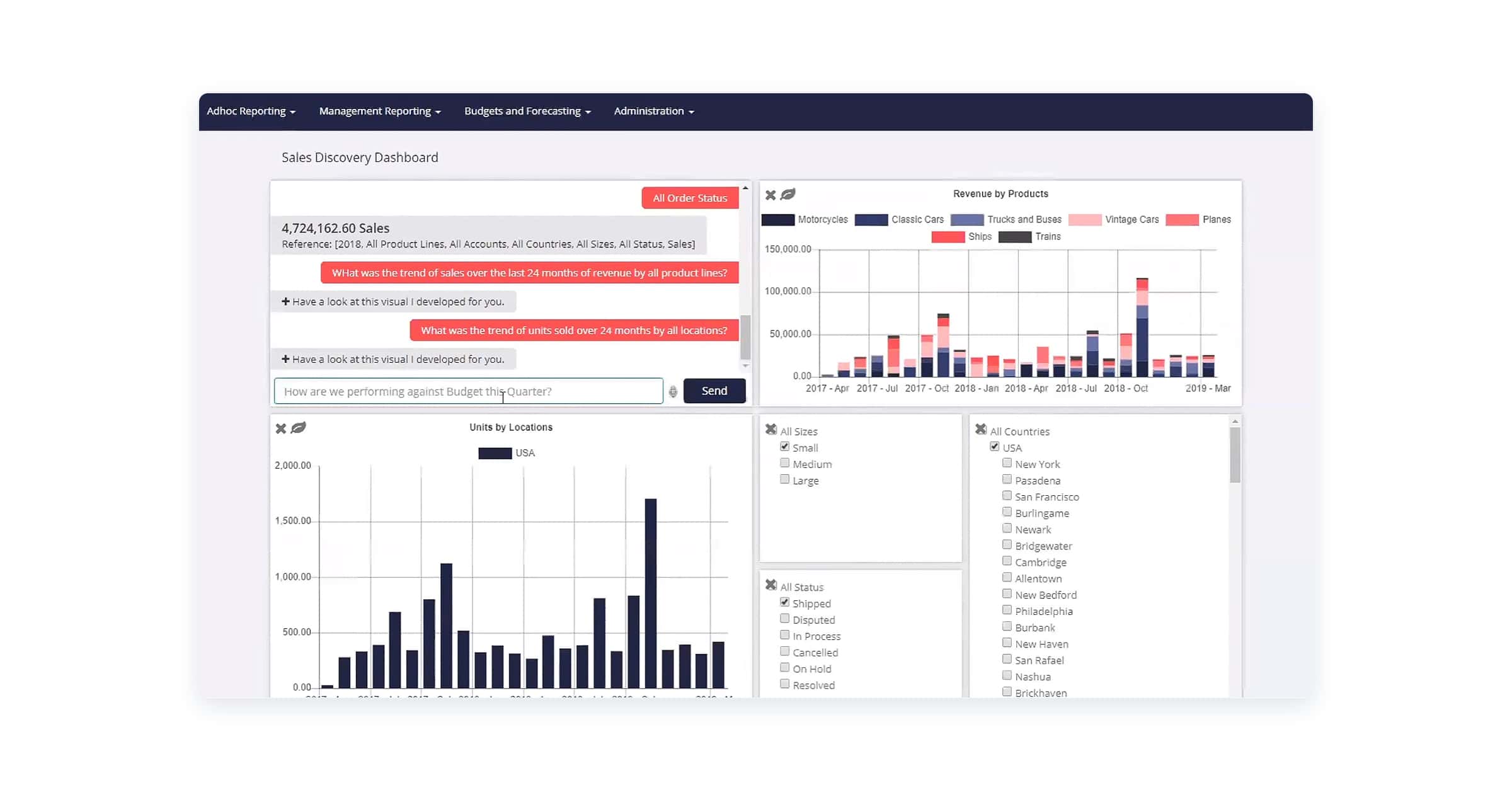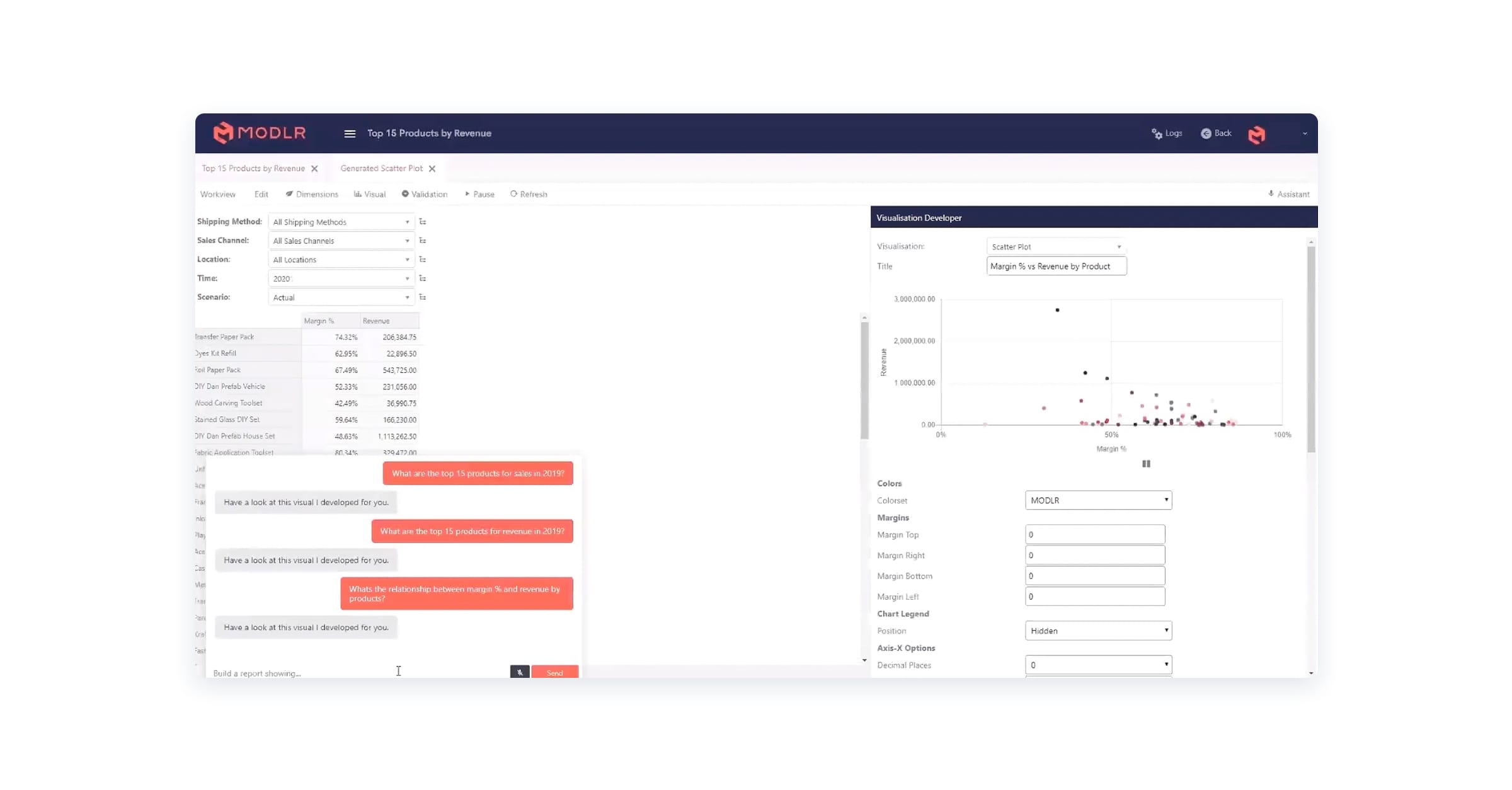Self-service analytics, also known as Ad Hoc Reporting, is a form of business intelligence which gives business users the ability to explore and gain rapid insights from their data, with minimal or no training. Self-service analytics empowers users through simplifying complex data models, enabling them to build dashboards and generate reports independently; eliminating the reliance on Finance or IT, allowing them to focus on high-value strategy.

When placed on the spectrum of business intelligence, self-service analytics lays one end of the spectrum, allowing independence for the end user to accomplish their tasks and duties with minimal assistance. This is contrasting to prescriptive analytics on the other end of the spectrum which provides end users with actionable insights for them to make their own decision making.

MODLR's Ad Hoc Reporting and Analysis Solution
Self-Service Analytics Software Capabilities and Advantages
Self-service analytics software provides users with not only the tools to build data visualisations on-the-fly, but to also access a range of functions to dive deeper into users' data with ease, such as drilling down, dynamic modification or quick calculations in reports. These functions provide users with the flexibility and independence to gain insights as and when they need them, fostering a data-driven culture across an organisation.
Self-service analytics enables all users to build and customise their own reports to cater towards their specific role's needs and functions. If an executive is concerned with the performance goals, revenue, and whether the company's KPIs are being met, self-service analytics visualises the relevant data around these metrics.
MODLR's Self-Service Analytics Features and NLP Technology
MODLR's self-service analytics capabilities go above and beyond the standard and provide end-users with an intuitive and seamless interface to build their reports and dashboards. Users can automate data imports from multiple different data sources with MODLR's wide-range of API integrations - including Excel - and perform a one click conversion into the CPM Cloud Platform. From there, any chart or report widget can be produced from a users' written or even spoken query - with MODLR's built-in innovative NLP technology. When producing chart visualisations, MODLR will determine the best chart type to highlight the data, from scatter plots to bar charts and trend graphs, based on the key phrases in users' queries. By prioritising the experience and ease of use for the end-user, MODLR makes the transition to self-service analytics as user-friendly and intuitive as possible.
View MODLR's self-service analytics built-in NLP technology here.

MODLR's Built-in Visualisation Developer
Why Should you Use Self-Service Analytics?
As many companies will know, IT and FP&A teams are critical proponents to the success of a company - making their time extremely valuable. Commonly these teams are found spending their time away assisting with other users' technical issues, or creating data reports for users with limited analytics expertise. Through self-service analytics, a great deal of responsibility and time can be alleviated for these teams, and a great deal of resources can be saved for the company as a whole. Business users are able to take control of their own data and analytical needs, developers are able to focus on advancing technology, and the finance teams are able to focus on maximising profit through strategic planning. As a whole, this extends the overall agility and efficiency of an organisations' processes and their strategic planning, creating higher returns and, in time, increasing profitability.
Self-service analytics is a necessary step beyond traditional reporting software. An organisation armed with self-service analytics is simply more equipped to explore and understand their data to identify high-value business insights faster than those shackled to traditional reporting software.
Data and its importance in Self-Service Analytics
Data is the centre point of knowledge for companies. Gathering data is vital for companies and their workforce to know what strengths, weaknesses and opportunities to target in their business strategy. A workforce that has ready access to data, and can analyse it and break it down to valuable insights can create great value for the company. Self-service capabilities work to make these processes more efficient, providing accessibility, agility and independence to users.
MODLR allows users to to organise and structure data according to their own organisation's preference. This is achieved through MODLR's 'workviews', which can be renamed, customised and automatically updated with the latest data from multiple data sources. Within these 'workviews' data can be formatted to suit the needs and preferences of the user, such as changes in font, colour themes, the name of a field, and hierarchies of data to use in drill-down analysis. For example, hierarchies such as time can be created to hours -> seconds, and altered to the users liking, such as weeks -> days -> hours -> seconds. MODLR houses plenty of other features including custom formulas and summaries that help create a flat data structure, making things easy for users to understand when using self-service analytics.
Why is Self-Service Analytics Important?
Traditional methods of resourcing actionable intelligence often resulted in cumbersome and lengthy processes between executives and financial teams. This was in part due to the difficulty and high learning curve of business intelligence software, which required skill sets and knowledge then found in developers, statisticians, and data scientists to create even a simple dashboard. Because of these barriers of knowledge, the accessibility to business intelligence had required great dedication and time to deliver relevant business insights to executives. Furthermore, the capabilities of data visualisation was extremely limited - meaning that translating data insights into valuable decisions was a far more difficult process.
This burdensome process became more and more difficult to maintain as the requirements of the business world evolved. Consumer behaviour and data became more complex, and business intelligence to understand these rapidly changing behaviours were sought out in matching speed and more accessible routes; executives wanted actionable insights, in simpler and faster terms. This led to market trends around building interactivity and ease of access within reports, dashboards and visualisations, making business intelligence software more accessible and impactful. As a result business intelligence software became more mainstream, and open to not just executives, but middle management and even end users.
In conjunction, demand for reporting and analytics grew rampant and put great pressure on teams such as finance and IT to keep up. This, in return, bolstered the demand for self-service capabilities for users from separate business divisions to be able to create solutions for themselves without the assistance of finance or IT. By the time of the arrival of self-service analytics software, it was more than welcomed as an effective solution to meet the needs of all teams.
Self-service analytics is especially pertinent, as data structures grow more complex and expand exponentially. Keeping up with warehousing, filtering and analysing this data rises as a greater challenge because of this deluge of information, as such the solution for companies has been to demand more effective and efficient adaptations of self-service analytics. This has led to the development of self-service analytics - pushing application developers to deliver analytical functions to the users instead of finance or IT staff. This creates a great reprieve for the finance and IT teams as they have a lower number of applications to manage as well as data resources.
Uncover Value From your Data with MODLR's Self-Service Analytics
MODLR's cutting edge self-service analytics caters exactly for the demand of modern-day business. With MODLR's self-service analytics application, teams in IT and finance teams can deliver self-service business intelligence capabilities without sacrificing time on UX, branding or strategy. The MODLR platform is custom-made from the ground up so that means our developers are able to easily adapt it to applications or needs of any business environment. MODLR's 'workviews' capabilities empower users to easily build, edit, manage and share any data visualisations they wish such as charts, dashboards and reports. Using MODLR's wide-range of advanced APIs, you can seamlessly adjust the business logic on the backend to reflect a look and feel of your choice in the front end without even needing to switch application interfaces.
Furthermore, as a multi-faceted platform and tool for business analytics, MODLR can cater for any method of approach, whether it is self-service led or prescriptive, the CPM Cloud can deliver on the needs of both worlds.






